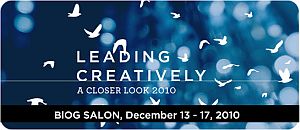This article originally appeared in the Leading Creatively Blog Salon, a week-long exploration of leadership in the creative sector, hosted by the National Alliance for Media Arts and Culture.
 When I first entered the workforce after graduate school, I believed that leadership originated at the top of the organizational pyramid and flowed downward. My first two jobs reinforced this belief: the senior leadership set the agenda for the organization, provided directives to the staff, and neither solicited nor desired the input of the junior staff. We were solely there to follow…or so I thought.
When I first entered the workforce after graduate school, I believed that leadership originated at the top of the organizational pyramid and flowed downward. My first two jobs reinforced this belief: the senior leadership set the agenda for the organization, provided directives to the staff, and neither solicited nor desired the input of the junior staff. We were solely there to follow…or so I thought.
In retrospect, I see that my professional life has always contained the simultaneous duality of leading and following. When I worked in entry-level positions, I followed my supervisor’s directives for actualizing the executive director’s vision in service of the mission. And I was happy to be doing it. Following the lead of the senior staff allowed me to learn a great deal about management and leadership in the arts. So where did I lead in those early days? In the organization’s blind spots.
Small and mid-sized organizations in the creative sector are often faced with human resource capacity issues. Everyone on staff tends to wear numerous “hats.” Correspondingly, there are always areas within these organizations in need of attention and innovation. Turning these blind spots into areas of opportunity takes three key leadership traits: vision, initiative and persuasiveness.
In my personal experience, the organizations that I worked with had significant blind spots in their technology infrastructures. Once I recognized this, I started envisioning ways in which the incorporation of new and/or different technologies could improve organizational efficiency, audience reach, depth of engagement, etc. Having the vision for change was not enough by itself, I had to take the initiative to approach the senior leadership and persuade them to pursue change via technology adoption.
As I rose through the ranks, those three traits remained pivotal for leadership. Now as an executive director, I have tried to consciously foster a working environment wherein other members of the staff are encouraged to lead. Obviously, this requires me to follow. When I first took on the executive role, I wondered if I would be one of those executives who just could not follow someone else’s lead. I mean, I was hired to lead, right? Wouldn’t choosing to let someone else take the lead in an area be shirking my duties?
Three years into the role, I know that the answer to this is “no.” We must embrace the duality of leading and following throughout our professional lives in order to foster and ensure the continuous development of our organizations and ourselves.
